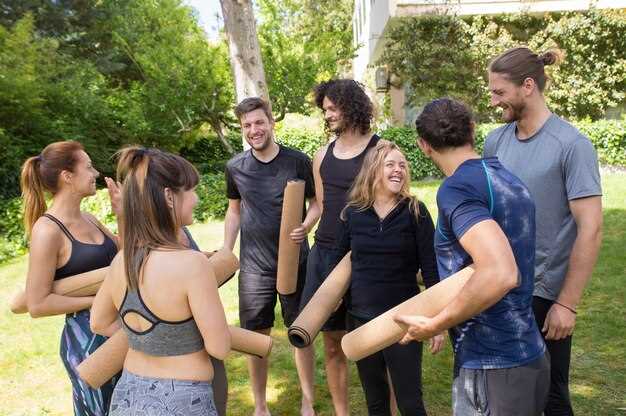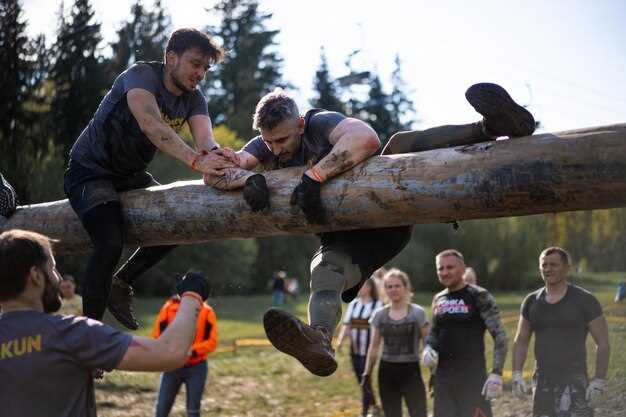To elevate performance in sports, teams must prioritize effective team building strategies. Engaging in regular team-building activities cultivates trust and communication, which translates into improved collaboration on the field. Research shows that teams with high cohesion outperform their less synchronized counterparts by over 20% in competitive scenarios. This statistic highlights the tangible benefits of focusing on team dynamics.
Incorporating diverse activities, from trust exercises to competitive challenges, can boost morale and reinforce relationships. For instance, a study found that teams participating in structured retreats saw a 30% increase in overall satisfaction among players. This satisfaction not only enhances the team’s spirit but also directly impacts their success during competitions.
A strong team environment encourages open communication. Regular meetings and feedback sessions enable players to express concerns and share ideas, leading to a more united approach to both training and matches. Establishing a clear vision for the team helps align individual goals with collective objectives, driving performance to new heights.
By making team building a priority, sports leaders can create a supportive culture that nurtures growth and resilience. Teams that invest in their dynamics are not just preparing to win; they are building a foundation for long-lasting success. Consider adopting engaging team-building practices to strengthen your group and maximize its potential.
Defining Team Culture in Sports

Establish clear values that resonate with all team members. Values like respect, commitment, and collaboration serve as guiding principles. Engage players in discussions to identify these core values, encouraging ownership and accountability. This inclusivity builds a sense of belonging and strengthens team bonds.
Communication Styles
Encourage open communication. Create an environment where players feel comfortable expressing their thoughts and concerns. Regular team meetings can facilitate this communication, allowing everyone to voice their opinions and share insights. Make use of feedback sessions that are constructive rather than critical; this nurtures trust and understanding.
Team Activities
Organize regular team-building activities that go beyond practice. Activities like group outings or workshops can break down barriers and reinforce relationships. Incorporating fun, non-competitive experiences aids in the development of interpersonal skills. These shared experiences enhance the team culture by fostering camaraderie, making each member feel valued and connected.
| Value | Action |
|---|---|
| Respect | Encourage players to support and appreciate one another. |
| Commitment | Set clear expectations regarding attendance and effort in practices and games. |
| Collaboration | Promote teamwork through drills that require working together to succeed. |
Monitor the evolving culture regularly. Collect feedback to ensure alignment with the established values. Adapt as needed while keeping core principles intact. Regular reflections on team dynamics enrich understanding and adaptation of the culture, reinforcing its significance in achieving team goals.
Identifying Key Elements of Team Motivation

Prioritize clear communication among team members. Regular team meetings create an environment where athletes express thoughts and concerns, fostering trust and unity. Encourage open dialogue, allowing everyone to contribute ideas and solutions.
Set specific and achievable goals. Break larger objectives into smaller, measurable tasks that team members can work towards together. Celebrating these milestones strengthens the bond within the team and keeps motivation high.
Recognize individual strengths and contributions. Acknowledge players’ unique skills and how they enhance the team’s overall performance. This approach not only boosts morale but also encourages players to take ownership of their roles.
Establish a culture of accountability. Hold each other responsible for both individual and collective outcomes. This mindset drives athletes to push themselves and their teammates, leading to a stronger commitment to team goals.
Incorporate team-building activities. Engaging in exercises outside of standard practice helps deepen relationships and improve collaboration on the field. Whether it’s participating in community service or team outings, these experiences create lasting bonds.
Encourage positive reinforcement among team members. Celebrating achievements, both big and small, fosters an uplifting atmosphere. Compliments and constructive feedback from teammates instill confidence and motivate individuals to strive for excellence.
Invite team involvement in decision-making. Letting athletes have a say in strategies and tactics cultivates a sense of ownership. This involvement enhances investment in shared goals and motivates players to perform at their best.
Employ varied training methods to maintain enthusiasm. Regularly introducing new drills and challenges keeps workouts fresh and engaging. This approach prevents stagnation and ensures that athletes remain excited about practice and competition.
Promote a balanced mindset towards competition. Focus not just on winning but also on personal growth and teamwork. Celebrating effort and improvement, regardless of the outcome, helps maintain motivation over the long term.
Practical Strategies for Fostering Team Cohesion

Schedule regular team-building activities that encourage collaboration and communication. Activities like trust falls, problem-solving challenges, or group outings create shared experiences that strengthen relationships.
Implement open communication channels. Use team meetings, chat apps, or bulletin boards to encourage team members to share ideas and concerns. This transparency builds trust and helps everyone feel included.
Recognize individual contributions publicly. Highlight achievements during team meetings to show appreciation and boost morale. This acknowledgment cultivates a positive environment where each member feels valued.
Establish clear goals and roles. Ensure that every team member understands their responsibilities and how they align with the overall objectives. Clarity helps reduce confusion and promotes accountability.
Encourage social interactions outside of practice or competition. Casual get-togethers help teammates connect on a personal level, enhancing camaraderie. Consider organizing dinners, game nights, or volunteer activities.
Utilize mentorship programs where experienced players support newer members. Pairing them helps build connections and allows the experienced players to share their knowledge and insights.
Conduct team reflection sessions after competitions. Gather feedback on performance and team dynamics, focusing on what went well and what could improve. This practice promotes continuous improvement and collective growth.
Promote a culture of inclusion and diversity. Celebrate different backgrounds and perspectives within the team to create a rich environment. Inclusivity enhances teamwork and boosts creativity in problem-solving.
Invest time in conflict resolution training. Equip team members with strategies to handle disagreements constructively. Addressing conflicts early prevents escalation and strengthens unity.
Finally, lead by example. Coaches and team leaders should model the behaviors they want to see, like respect, openness, and collaboration. Leadership sets the tone for the overall team dynamic.
Role of Leadership in Shaping Team Dynamics

A strong leader sets the tone for team dynamics by establishing clear communication and trust. Leaders must actively engage with their athletes, ensuring everyone feels valued and heard.
Here are specific ways leadership shapes team dynamics:
- Communication: Open lines of dialogue encourage feedback and collaboration. Regular check-ins can help identify issues before they escalate.
- Trust Building: Leaders should model reliability by following through on commitments. Trust fosters an environment where athletes feel safe to take risks and express themselves.
- Conflict Resolution: Effective leaders address conflicts promptly and fairly. Bringing opposing views together for constructive discussions can strengthen relationships within the team.
- Goal Setting: Leaders guide teams in setting achievable goals that align with each member’s strengths. This shared vision boosts motivation and accountability.
Additionally, a leader’s behavior influences the team’s culture. Positive reinforcement and recognition of individual achievements help maintain high morale.
Encourage team-building activities that promote collaboration and bonding. These experiences can deepen relationships and enhance understanding among team members.
Monitoring team dynamics is crucial. Leaders should stay attuned to group interactions, adjusting strategies as necessary to maintain a cohesive environment.
In sum, effective leadership creates a robust foundation for team dynamics that leads to success. Utilize these strategies to inspire your team and foster a supportive athletic community.
Communicating Goals to Create a Unified Vision
Clearly defined goals enhance team cohesion. Ensure every member understands the team’s objectives through regular meetings and clear messaging. Utilize visual aids like charts or progress reports to keep everyone on track and motivated.
Set SMART Goals
Establish Specific, Measurable, Achievable, Relevant, and Time-bound (SMART) goals. This framework allows each athlete to understand their role and contributions to the team’s success. For example, instead of saying “improve fitness,” specify “increase sprinting speed by 10% over the next month.” This clarity drives focus and purpose.
Encourage Open Feedback
Promote an environment where team members feel comfortable sharing their thoughts. Regular feedback sessions boost trust and engagement. Allow players to voice concerns or suggestions regarding team strategies. Active listening helps coaches adapt plans and keeps everyone aligned with common objectives.
Celebrate milestones together. Acknowledge achievements, no matter how small, to reinforce commitment and unity. This positive reinforcement keeps the team motivated and fosters a sense of shared purpose, essential for building a strong, cohesive team atmosphere.
Utilizing Team Building Activities for Enhanced Performance
Engaging in regular team building activities significantly boosts team cohesion and performance. One effective method is to schedule monthly workshops focused on communication skills. These workshops can incorporate role-playing exercises that challenge team members to express themselves and listen actively. This practice sharpens their ability to collaborate during high-pressure game situations.
Incorporating Outdoor Challenges
Outdoor challenges create opportunities for team members to build trust and camaraderie. Choose activities like obstacle courses or scavenger hunts tailored to your team’s physical capabilities. These challenges require teamwork and problem-solving, reinforcing group dynamics and encouraging players to rely on each other’s strengths.
- Set clear objectives for each activity to ensure focused participation.
- Encourage reflection sessions post-activity to discuss strategies and experiences.
- Celebrate achievements, no matter how small, to boost morale.
Promoting Friendly Competition
Friendly competition can motivate teams. Organize internal tournaments or game nights where players form mixed teams. This breaks down existing hierarchies and fosters new relationships. Implement rules that encourage support and sportsmanship, ensuring competition remains constructive.
- Establish guidelines for maintaining a supportive atmosphere.
- Rotate teams regularly to promote interaction among all members.
Team building activities are not just fun; they develop essential skills that translate directly into performance improvements on the field. Commit to a structured approach, and watch your team’s synergy flourish. Regular engagement through these activities yields measurable benefits in teamwork, communication, and overall game performance.
Measuring the Impact of Team Building Initiatives
Track performance metrics before and after team building activities. Analyze changes in player statistics, teamwork effectiveness, and game outcomes to identify any correlations. Use surveys to gather feedback from team members about their experiences and perceived improvements in communication and cooperation.
Hold regular assessments to evaluate team dynamics. Conduct observations during practices and games, noting improvements in teamwork and collaboration. Compile data from different sources like coaches, players, and support staff to create a well-rounded view of the team’s progress.
Set specific goals for team building initiatives, such as enhancing trust, boosting morale, or improving conflict resolution. Compare pre-initiative baselines with post-initiative outcomes to measure success. This approach clarifies which aspects of team building truly lead to beneficial changes.
Create an environment of accountability by encouraging team members to share their personal goals related to teamwork. This practice strengthens relationships and enhances the overall team atmosphere, which can lead to improved performance on the field.
Incorporate physical and mental resilience training into team building. Measure improvements in stress management and coping mechanisms through surveys or workshops. Evaluate players’ responses in high-pressure situations to see if team cohesion translates into on-field success.
Lastly, monitor retention rates and team satisfaction over time. Higher retention often indicates a positive team culture fostered by successful team building initiatives. Regularly revisit goals and adjust strategies to maintain growth and engagement within the team.
Addressing Conflicts to Strengthen Team Relationships
Encourage open communication among teammates to address conflicts directly. Establish a safe space where players feel comfortable expressing their feelings. Regular team meetings or informal check-ins create opportunities for discussion and resolution. Use active listening techniques; let each person explain their point of view without interruption.
Conflict Resolution Strategies
Implement specific strategies such as mediation sessions led by a team captain or coach. This approach allows for impartial discussions and fosters a sense of teamwork in resolving issues. Encourage players to focus on behavior rather than personal attacks, which helps to maintain respect and camaraderie. Problem-solving workshops can also provide tools for conflict management, equipping athletes with skills to navigate disagreements constructively.
Building Trust Through Conflict
Resolving conflicts effectively builds trust within the team. When players witness successful resolutions, they become more likely to engage in open dialogue. Encourage teammates to collaborate in finding solutions, reinforcing their relationships and promoting unity. Recognizing and celebrating the resolution of disputes contributes to a positive team culture, benefiting overall performance and morale.
Celebrating Successes to Boost Team Morale
Establish regular recognition events to celebrate achievements, both big and small. Recognizing hard work fosters a sense of accomplishment and unity. For instance, hold weekly meetings where players can share successes, from personal goals to team victories. This creates a culture of appreciation that resonates through the group.
Utilize Creative Rewards
Implement fun and meaningful rewards for achieving team goals. This could range from a special team dinner to personalized certificates highlighting individual contributions. Make these rewards unique to your team’s culture and values. A well-thought-out reward system motivates athletes to put in their best efforts, reinforcing the idea that their hard work truly matters.
Create a Visual Success Board
Set up a success board in a common area. Display achievements, quotes, and photos capturing memorable moments. Update it regularly to reflect both team and individual milestones. This visual representation not only boosts morale but also serves as a constant reminder of progress and shared goals.
Encourage players to share their feelings and stories related to successes. These discussions deepen connections among teammates, ensuring that everyone feels valued. Celebrate together to strengthen bonds and ignite enthusiasm for future challenges.
Continuous Improvement: Evolving Team Strategies
Implement regular strategy review sessions to assess the team’s performance. Gather data from various matches to pinpoint strengths and weaknesses. Allow players to voice their insights, creating a sense of ownership over the process. This collaborative approach fosters innovative ideas that can enhance game tactics.
Adaptability in Training
Incorporate flexible training modules that can be adjusted based on upcoming opponents. Analyze their play styles and weaknesses. Tailor practice sessions to simulate real-game scenarios. This customized training prepares players for specific challenges, boosting their confidence and performance during matches.
Utilizing Technology
Leverage analytics tools to track player performance and team dynamics. Use video analysis to break down specific plays or strategies, allowing players to visually understand their roles. Encourage team discussions around these analyses to promote strategic thinking and adaptability during games.
Video:
Best Team Building Activities | Smart Skills
Best Team Building Activities | Smart Skills by Smart Skills TV 3,263,740 views 6 years ago 3 minutes, 14 seconds
Q&A:
Why is team building considered important in sports?
Team building is fundamental in sports as it strengthens relationships among team members, enhances communication, and fosters a shared sense of purpose. When athletes work well together, they can improve their performance, strategize more effectively, and develop trust both on and off the field. A cohesive team can tackle challenges more efficiently and create a supportive environment that encourages individual growth and collective success.
How can team building activities improve performance in sports teams?
Engaging in team building activities can significantly enhance performance by promoting collaboration and unity. These activities help athletes learn to rely on each other, create rapport, and develop leadership skills. For instance, participating in trust falls or team challenges forces athletes to communicate effectively and strategize collectively. This practice transfers to actual games, as team members become more adept at anticipating each other’s moves and supporting one another during high-pressure situations.
What specific team building exercises are effective for sports teams?
Various exercises can be employed to strengthen sports teams, such as relays, team obstacle courses, or group problem-solving tasks. Activities like “The Minefield,” where one member is blindfolded and guided by teammates, enhance trust and communication. Additionally, organizing social events outside of training can reinforce bonds. The key is to select activities that challenge team members and encourage collaboration while being enjoyable and engaging.
Can team building positively impact the mental health of athletes?
Absolutely. Team building contributes to better mental health by creating an environment of support and understanding. Athletes facing pressure might feel isolated, but strong team bonds foster a sense of belonging and reduce anxiety. Open lines of communication allow team members to share their struggles and accomplishments, promoting a positive psychological space. This camaraderie ultimately leads to improved morale, resilience, and performance on the field.
What challenges do sports teams face in team building?
Sports teams often encounter several challenges in team building, including diverse personalities, varying skill levels, and conflicts among members. Differences in communication styles and expectations can lead to misunderstandings. Moreover, teams may struggle to find the time and resources for team-building activities, especially during competitive seasons. Addressing these challenges requires patience, consistent effort, and a willingness to adapt strategies to meet the unique needs of the team.
Why is team building important in sports?
Team building is crucial in sports because it cultivates a sense of unity and cooperation among team members. When athletes work together harmoniously, they develop trust and improve communication skills, which are vital during competitions. A well-built team enhances overall performance, as players understand each other’s strengths and weaknesses, leading to better strategic play. Additionally, strong team bonds can lead to increased motivation and support among players, helping them overcome challenges both on and off the field.
How can a team effectively build relationships among its members?
Building relationships within a team can be achieved through various activities that promote interaction and understanding. Organizing team outings or retreats allows members to engage in informal settings, enhancing camaraderie. Regular team meetings where players can openly communicate their thoughts and feelings also play a significant role. Coaches can implement trust-building exercises and focused training sessions, designed to improve teamwork skills. Encouraging open discussions around personal goals and team objectives fosters a culture of accountability and mutual support. As relationships strengthen, players become more likely to collaborate effectively during competitions, leading to enhanced performance.